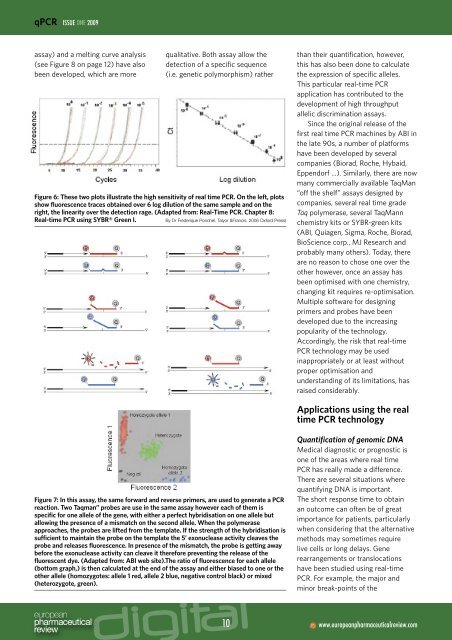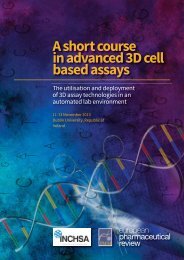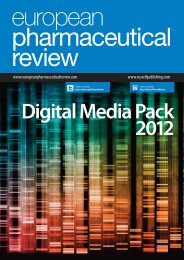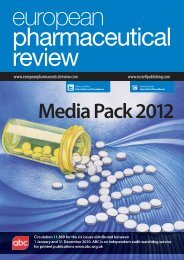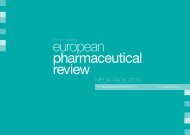Real time PCR - European Pharmaceutical Review
Real time PCR - European Pharmaceutical Review
Real time PCR - European Pharmaceutical Review
You also want an ePaper? Increase the reach of your titles
YUMPU automatically turns print PDFs into web optimized ePapers that Google loves.
q<strong>PCR</strong> ISSUE 2009<br />
assay) and a melting curve analysis<br />
(see Figure 8 on page 12) have also<br />
been developed, which are more<br />
qualitative. Both assay allow the<br />
detection of a specific sequence<br />
(i.e. genetic polymorphism) rather<br />
Figure 6: These two plots illustrate the high sensitivity of real <strong>time</strong> <strong>PCR</strong>. On the left, plots<br />
show fluorescence traces obtained over 6 log dilution of the same sample and on the<br />
right, the linearity over the detection rage. (Adapted from: <strong>Real</strong>-Time <strong>PCR</strong>. Chapter 8:<br />
<strong>Real</strong>-<strong>time</strong> <strong>PCR</strong> using SYBR® Green I.<br />
By Dr Frederique Ponchel. Talyor &Francis. 2006 Oxford Press)<br />
than their quantification, however,<br />
this has also been done to calculate<br />
the expression of specific alleles.<br />
This particular real-<strong>time</strong> <strong>PCR</strong><br />
application has contributed to the<br />
development of high throughput<br />
allelic discrimination assays.<br />
Since the original release of the<br />
first real <strong>time</strong> <strong>PCR</strong> machines by ABI in<br />
the late 90s, a number of platforms<br />
have been developed by several<br />
companies (Biorad, Roche, Hybaid,<br />
Eppendorf …). Similarly, there are now<br />
many commercially available TaqMan<br />
“off the shelf” assays designed by<br />
companies, several real <strong>time</strong> grade<br />
Taq polymerase, several TaqMann<br />
chemistry kits or SYBR-green kits<br />
(ABI, Quiagen, Sigma, Roche, Biorad,<br />
BioScience corp., MJ Research and<br />
probably many others). Today, there<br />
are no reason to chose one over the<br />
other however, once an assay has<br />
been optimised with one chemistry,<br />
changing kit requires re-optimisation.<br />
Multiple software for designing<br />
primers and probes have been<br />
developed due to the increasing<br />
popularity of the technology.<br />
Accordingly, the risk that real-<strong>time</strong><br />
<strong>PCR</strong> technology may be used<br />
inappropriately or at least without<br />
proper optimisation and<br />
understanding of its limitations, has<br />
raised considerably.<br />
Applications using the real<br />
<strong>time</strong> <strong>PCR</strong> technology<br />
Figure 7: In this assay, the same forward and reverse primers, are used to generate a <strong>PCR</strong><br />
reaction. Two Taqman” probes are use in the same assay however each of them is<br />
specific for one allele of the gene, with either a perfect hybridisation on one allele but<br />
allowing the presence of a mismatch on the second allele. When the polymerase<br />
approaches, the probes are lifted from the template. If the strength of the hybridisation is<br />
sufficient to maintain the probe on the template the 5’ exonuclease activity cleaves the<br />
probe and releases fluorescence. In presence of the mismatch, the probe is getting away<br />
before the exonuclease activity can cleave it therefore preventing the release of the<br />
fluorescent dye. (Adapted from: ABI web site).The ratio of fluorescence for each allele<br />
(bottom graph,) is then calculated at the end of the assay and either biased to one or the<br />
other allele (homozygotes: allele 1 red, allele 2 blue, negative control black) or mixed<br />
(heterozygote, green).<br />
Quantification of genomic DNA<br />
Medical diagnostic or prognostic is<br />
one of the areas where real <strong>time</strong><br />
<strong>PCR</strong> has really made a difference.<br />
There are several situations where<br />
quantifying DNA is important.<br />
The short response <strong>time</strong> to obtain<br />
an outcome can often be of great<br />
importance for patients, particularly<br />
when considering that the alternative<br />
methods may some<strong>time</strong>s require<br />
live cells or long delays. Gene<br />
rearrangements or translocations<br />
have been studied using real-<strong>time</strong><br />
<strong>PCR</strong>. For example, the major and<br />
minor break-points of the<br />
10<br />
www.europeanpharmaceuticalreview.com


